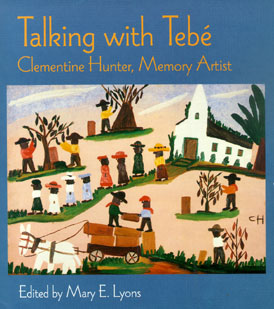
Talking with Tebé:
Clementine Hunter, Memory Artist
(Houghton Mifflin Company, Fall 1998. ISBN 0-395-72031.)
Clementine Hunter was born in Louisiana in 1886. Called Tebé by her family, Hunter lived and worked on Melrose Plantation for more than 75 years. Her art tells the southern laborer's story. In colors as bright as the Louisiana sky, she shows the backbreaking work required to pick cotton, gather figs, cut sugar cane, and harvest pecans. Tebé's art portrays good times, too. Scenes of baptisms, weddings, and church socials celebrate a rich community life.
Mary Lyons gathered this text from Clementine Hunter's own words in magazine and newspaper articles and taped interviews. Step into these pages to meet Tebé. Sit loose and enjoy your talk with her. Let the artist's lively words and colorful pictures carry you way down yonder to Cane River as it was one hundred years ago.
A Review
Talking with Tebé: Clementine Hunter, Memory Artist
Edited by Mary E. Lyons
This compelling biography of an African-American
sharecropper who gained national recognition as a self-taught artist blends
southern history with the story of a spirited, independent woman worth knowing
about. Born in 1886, Clementine Hunter remembered seeing her father pick four
hundred pounds of cotton in a day. She herself set babies on the end of a cotton
row, while she worked for less than two dollars a day. Clementine painted her
first picture on a shoebox top with old tubes of paint found in a wastebasket.
Before she died in 1988, at the age of 101, her work had been displayed in
museums across the country. Editor Mary Lyons has masterfully pieced together
audio and print interviews to allow Clementine to tell her amazing story in her
own words. The result is an intimate visit with a woman who expressed her soul
through art created late at night after a full day's work. Color illustrations
give examples of Hunter's work with informative captions. Art teachers will be
delighted by the elegant explanation of folk art. Social studies teachers will
love the vivid historical lessons. Every reader who comes in contact with this
book will be enriched. 1998, Houghton Mifflin, Ages 9 to 12, $16.00.
Reviewer: Jackie Hechtkopf
www.africanafrican.com
Read another review.
